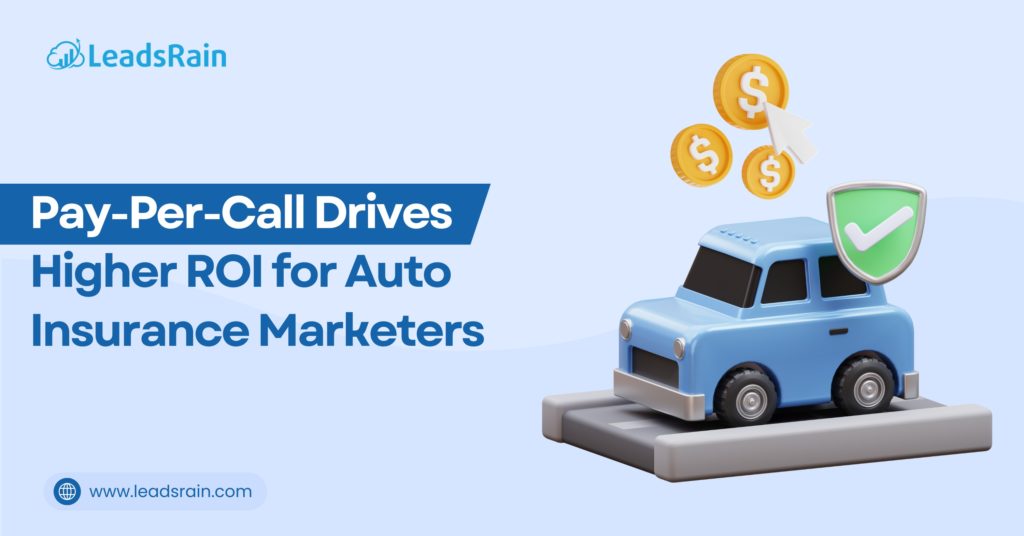A few years ago, I sat in on a quarterly review with a regional auto insurance agency. They were spending over $20K a month on digital ads—Google Ads, Facebook, even some programmatic displays. Their dashboard showed thousands of clicks, hundreds of form fills… but barely a handful of actual policies sold.
Sound familiar?
Here’s the dirty secret no one wants to admit: most online insurance leads are ghosts. They fill out a form, get spammed by 10 carriers, and vanish. Meanwhile, you’re stuck paying for a “lead” that never picks up the phone.
But there’s a shift happening—quietly, under the radar. Agencies that are actually growing aren’t chasing form fills anymore. They’re betting on pay-per-call. And it’s working
What is Pay-Per-Call in Auto Insurance?
Actually it’s quite simple to understand: You run an ad. Someone sees it, clicks a “Call Now” button, and talks to your agent. You only pay when that call happens—and usually only if it’s a “real” call.
You might be thinking of it like performance marketing, but instead of paying for a click that might lead to a sale… you pay for the conversation that is the sale.
In auto insurance, where 68% of shoppers still want to talk to a human before buying , this isn’t just smart—it’s obvious.
Why Auto Insurance Converts Better Over the Phone?
Auto insurance is a considered purchase that often requires clarification on coverage options, discounts, state requirements, and claims processes. Many consumers prefer speaking with a licensed agent before making a decision.
Data from the National Association of Insurance Commissioners (NAIC) and J.D. Power consistently shows that phone interactions significantly increase the likelihood of policy issuance. Calls allow agents to:
- Verify driver and vehicle details in real time
- Address concerns about premiums or coverage gaps
- Offer personalized bundling or loyalty discounts
- Complete the application during the initial conversation
This immediacy reduces drop-off and accelerates the sales cycle.
Pay per call for Auto Insurance – Direct Impact on ROI and Operational Efficiency
Insurers using pay-per-call report measurable improvements across key performance indicators:
1. Lower Cost Per Acquisition (CPA)
Since payment is contingent on a qualified call—not a click or form submission—ad spend is directed only toward engaged prospects. This eliminates waste from invalid traffic, accidental clicks, or unresponsive leads.
2. Higher Conversion Rates
Calls represent active buying intent. Industry data indicates that call-based leads convert at 25–35% in auto insurance, compared to 5–12% for web form leads, depending on market and carrier.
3. Better Lead Qualification
Modern pay-per-call platforms integrate with IVR systems and CRM tools to filter calls based on duration, keyword triggers, or caller responses. For example, a call must last longer than 60 seconds or include a menu selection for “new auto quote” to be billable.
4. Transparent Attribution
Each call is tracked to its source—whether a Google Ads campaign, insurance comparison site, or mobile display ad. This enables precise ROI calculation by channel, keyword, or publisher.
Implementation Strategies of Pay per call approach in Auto Insurance Business
Successful adoption of pay-per-call requires strategic integration:
- Dedicated Tracking Numbers: Assign unique phone numbers to each campaign or partner to isolate performance data.
- Call Scoring Rules: Define what constitutes a “billable” call (e.g., minimum duration, geographic match, IVR path).
- Agent Readiness: Ensure front-line staff are trained to handle inbound quote requests efficiently and compliantly.
- CRM Integration: Automatically log call metadata (time, source, duration) into the agency management system for follow-up and reporting.
- Compliance Safeguards: Record calls where required by state law and maintain TCPA compliance through proper consent mechanisms.
Many insurers begin by reallocating a portion of their PPC or lead-buying budget to test pay-per-call with trusted publishers or through self-serve platforms like Google’s call extensions.
How to measure success in Pay per call for Auto Insurance business post call?
While the call itself is the conversion event in pay-per-call, insurers should track downstream outcomes to validate ROI:
- Policy bind rate from call leads
- Average premium per bound policy
- Time from first call to policy issuance
- Customer retention at 6 and 12 months
These metrics confirm whether call-based leads not only convert faster but also represent higher-quality, longer-lasting customers.
Conclusion
Pay-per-call is not a replacement for all digital channels—but it is a high-efficiency complement to them. For auto insurers seeking to reduce wasted ad spend and connect directly with ready-to-buy consumers, it offers a clear path to improved ROI.
As consumer behavior continues to favor instant, human-assisted service—even in digital-first journeys—the phone call remains one of the most reliable indicators of purchase intent. Insurers who structure their marketing around this reality are better positioned to grow profitably in a competitive market.Wanted to check out how this approach can help you grow your Auto insurance business? – Drop us a line now at support@leadsrain.com
